Normally this series is on the blog side of the site, but since this is an extra-long edition, I’ve made it an article. If you’re new to “Longest Plate Appearance of the Week” because you don’t read the blog section regularly, A) read the blog section regularly! and B) catch up on the first edition here and the second edition here. I’ve added a few new elements this week: the length of the plate appearance, the number of mound visits involved, and a GIF of an exhausted player who’s wishing the plate appearance would end.
Bonus long plate appearance trivia: I don’t know why I didn’t think to look it up before, but if we’re going to talk about long plate appearances every week, we should know what the gold standard in long plate appearances is. The pitch-by-pitch data in our database goes back to 1988, and in that time, the longest plate appearance was a 20-pitch battle between Bartolo Colon and Ricky Gutierrez on June 26, 1998. Gutierrez struck out swinging. So, 20 pitches: that’s the goal. The average plate appearance in 1998 was 0.15 pitches shorter than today’s, so we have a head start.
Longest Plate Appearance(s) of the Week, 5/16-5/22
May 17, Diamondbacks at Marlins
Kevin Slowey vs. Paul Goldschmidt, 13 pitches (tied for longest of 2013)
AND
May 18, Brewers at Cardinals
Trevor Rosenthal vs. Carlos Gomez, 13 pitches (tied for longest of 2013)
For the first time, we have a tie! I wrote in week one that when we had a tie, I would pick the most interesting PA and write about that one. That is what I’ll do most times there are ties, but both of this week's two contenders were interesting in completely different ways. I couldn’t choose between them, so I’m writing about both. We’ll start with Slowey vs. Goldschmidt and wrap up with Rosenthal vs. Gomez .
Slowey vs. Goldschmidt
Length: 6:02
Mound visits: 0
Goldschmidt’s longest previous plate appearance: 11 pitches
Previous longest plate appearance vs. Slowey: 15 (Scott Rolen, 2008)
2013 League-average P/PA: 3.85
Goldschmidt P/PA: 4.38. Goldschmidt ranks sixth in the majors in pitches per plate appearance (min. 100 PA), so seeing him here makes sense.
Slowey P/PA against: 3.83
Previous match-up history: 1-for-1, HR (earlier in same game)
The plot:

This is Slowey, career walker of 1.5 per nine, so naturally everything is right around the plate.
The exhausted player(s):
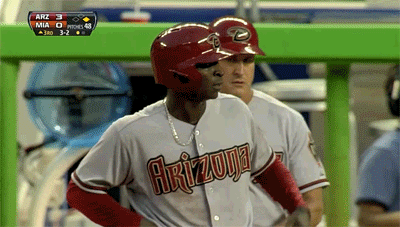
That was one continuous shot. It was 81 degrees in Arizona, batting helmets are hot, and swinging makes you sweat. So does breaking from first four times (and scrambling back to first once) during a 13-pitch plate appearance. Poor Didi Gregorius.
The sequence:
1. 0-0: 80-mph slider, ball

You know what you're going to get from Slowey, and it's not super-exciting to watch. Fastballs and sinkers in the 89-90 range, 60-65 percent of the time, with the other 35-40 percent of his offerings comprising sliders, changeups, and curveballs, none of them moving much over 80 miles per hour. He won't walk you, and when you put a pitch in play, there's about a 50-50 shot of it being a fly ball.
Slowey starts Goldschmidt off with slow slider that's not as far from the strike zone as Rob Brantly makes it look (see the strike zone plot). In an interview running next week at Grantland, Ryan Hanigan told me that the biggest mistake he sees inexperienced catchers make is "giving up" on getting a call too quickly on borderline pitches and turning the glove to receive the pitch with the wrist pointing up. That's what Brantly does here, even though Slowey hardly misses his spot. The ball almost pops out of his glove, as if it's higher than he'd expected (or as if he has his eyes on Didi Gregorius at first).
2. 1-0: 89-mph four-seamer, ball

Slowey comes back with his heater on the outside corner. This pitch looks even more like a strike, and Brantly does an okay job of selling it, but home plate umpire Adrian Johnson isn't buying. Now Goldschmidt has a couple pitches to play with before the count can even up.
3. 2-0: 89-mph four-seamer, called strike

Same pitch, but more centered. This one's a strike.
4. 2-1: 83-mph changeup, foul tip

A changeup that gets too much of the middle, and Goldschmidt likes it so much he almost sprains his front foot swinging. The change of speed has him just slightly out in front, which is all that saves Slowey.
5. 2-2: 90-mph sinker, foul

Slowey changes speeds and locations, going up and away for the first of many fouls.
6. 2-2: 89-mph four-seamer, ball

This is the farthest away from the strike zone Slowey is going to get. Goldschmidt lets it go by for ball three. The count is full, and we're not even halfway through this thing.
7. 3-2: 90-mph four-seamer, foul

This is the first of six consecutive pitches on (or slightly off) the outside part of the plate. Slowey saw Goldschmidt hit a ball 400 feet in the first, so he respects his power.
8. 3-2: 90-mph sinker, foul

Slowey lives low and away. Goldschmidt tries to pull the outside sinker and dribbles it foul.
9: 3-2: 89-mph sinker, foul

Another outside sinker Goldschmidt fights off but can't square up.
10: 3-2: 91-mph four-seamer, foul

This is the hardest pitch of the sequence, but Slowey doesn't have the velo to blow the ball by Goldschmidt. The best he can do is keep it away from the heart of the plate.
11: 3-2: 90-mph four-seamer, foul

Goldschmidt remains in protect mode, waiting for a pitch that isn't on the corner.
12: 3-2: 90-mph sinker, foul

I'm out of things to say about Goldschmidt fouling off outside sinkers. Slowey hasn't thrown anything off-speed since his fourth pitch.
This is the sixth consecutive foul ball of the at-bat, and both the guy throwing the five-ounce ball at high speed and the guy swinging the 30-something-ounce bat at an even higher speed have to be tiring. Maybe you're wondering whether the hitter has an advantage after seeing so many pitches from the same pitcher in the same plate appearance. Five years ago, Russell Carleton looked into whether the batter performs any better than expected after fouling off a two-strike pitch:
If the batter is fouling off two-strike pitches after being behind in the count, it means that he’s more likely to get on base (even though that effect is not linear with more fouls predicting higher OBP). But after the count evens, there’s no particular advantage to fouling off a lot of pitches.
Okay then! But what about after fouling off multiple two-strike pitches?
Seems like that even if the batter is behind in the count, if he’s still at least making contact, it’s a good sign. However, the effects don’t seem to grow by huge margins when the batter spoils multiple pitches. Talk of the pitcher having to “show” the batter extra pitches and this being a net gain for the batter doesn’t seem to hold water, at least as far as this particular batter being able to get on base in this particular at bat. A lot of foul balls do, however, extend the pitcher’s pitch count, which might be helpful later in the game. But, too often, commentators say that the batter is having “a good at-bat” if he fouls off a lot of 2-2 and 3-2 pitches. In fact, he’s not likely to be having a better or worse at bat in terms of his result than if he hadn’t fouled those pitches off.
So Goldschmidt isn't more likely to, say, hit a homer on the next pitch because he's seen so much of Slowey's stuff. However, he would be more likely to hit a homer if Slowey were to groove one right over the middle. Speaking of which:
13: 3-2: 90-mph four-seamer, in play

Sooner or later, Slowey was bound to make a mistake. He didn't miss by much—Brantly set up on the inside corner, hoping Goldschmidt wouldn't expect it after the barrage of outside pitches, and Slowey left it a little up and over the plate—but it was enough for Goldschmidt to do what he tried to do on his earlier, almost-ankle-spraining swing.
Marlins Park is one of the hardest places to hit homers, so it's the perfect park for an extreme flyball pitcher like Slowey. But against Goldschmidt, there is no perfect park. Over his first two seasons, Goldschmidt had a .769 OPS vs. right-handed pitchers and a .996 OPS vs. left-handed pitchers. His splits this season are .998 and .992. It's such a small sample, where platoon splits are concerned—141 PA against right-handers—that it might not be worth mentioning, but Diamondbacks fans could get used to this. A Goldschmidt who hits righties is really, really good. If his current-season splits are just the latest example of Goldschmidt's "tremendous makeup" helping him become better than we thought he could be—he was never a top prospect, so he's already exceeded expectations—he's going to be a bargain.
***
Rosenthal vs. Gomez
Length: 5:12
Mound visits: 1
Gomez’s longest previous plate appearance: 13 pitches
Previous longest plate appearance vs. Rosenthal: 11 pitches
2013 League-average P/PA: 3.85
Gomez P/PA: 3.94
Rosenthal P/PA against: 4.25
Previous match-up history: 1-for-5, 2K. Counting this plate appearance and another matchup the following day, Rosenthal has now faced Gomez seven times, more often than he's pitched to any other hitter.
In his first two at-bats of this game, Gomez conserved energy by striking out looking on three pitches and popping up on the first pitch, so he was prepared for an epic plate appearance. Still, as recently as last season, it would have been even stranger to see a plate appearance involving the aggressive Gomez last this long. This season, though:

Gomez is as aggressive as ever: he hasn't really reduced his rate of out-of-zone swings, and overall he's swinging more often than ever. The increase has come from swings at pitches inside the strike zone, which are generally the ones at which you want to swing.

The more Gomez swings at those over-the-plate pitches, the less often pitchers throw them. And that's because of what happens when he hits them:

So Gomez isn't walking more, but he is seeing more pitches, both because pitchers are approaching him more carefully (due to his increased power and tendency to swing at strikes) and because some of the swings that used to be whiffs have turned into fouls, prolonging his plate appearances. It's going to prolong this one more than most.
The plot:

Scavenger hunt: Can you find pitch no. 12 on this plot? It's there, but it's well-hidden.
The exhausted player:
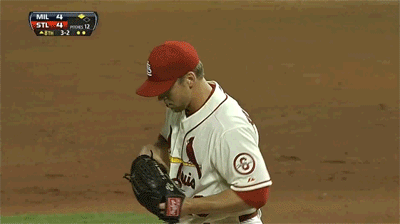
The sequence:
1. 0-0: 96-mph four-seamer, ball
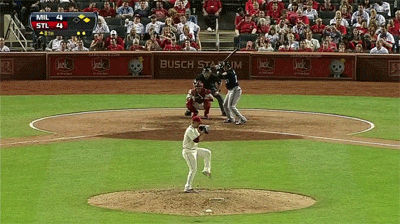
Rosenthal couldn't be much less like Kevin Slowey. He throws his heater on 80 percent of his pitches, and his heater is hard. Get ready to see some fastballs! This one is outside, and Gomez lets it go, which is notable because Gomez takes the first pitch of a plate appearance less often than any other batter in baseball. He swings at the first pitch 50 percent of the time (up from 38 percent as a rookie).
2. 1-0: 96-mph four-seamer, called strike
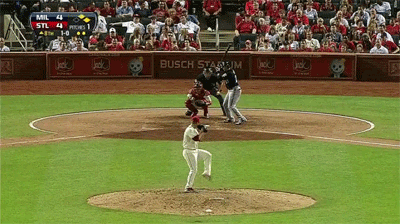
Another four-seamer at 96, this time on the opposite side of the plate. Yadier Molina does a nice job of stopping it before it can move any farther inside.
3. 1-1: 97-mph four-seamer, swinging strike

Rosenthal goes back outside, this time at 97, and Gomez chases up.
4: 1-2: 98-mph four-seamer, foul

A little harder, a little lower, and a little closer to the plate. Gomes goes for it again.
5: 1-2: 98-mph four-seamer, foul

The GIF makes it look like Gomez swung through this pitch, but he got a piece of it. You can see Molina tracking it at the end.
6: 1-2: 98-mph four-seamer, foul

On the strike zone plot above, pitches no. 5 and 6 are almost on top of each other. Not only does Rosenthal throw 80 percent fastballs, he throws some of them in the same spots on consecutive pitches. Clearly, he trusts his stuff. If you've seen his stuff, you probably trust it too.
Let's return to Russell's research, specifically the part that says: "If the batter is fouling off two-strike pitches after being behind in the count, it means that he’s more likely to get on base." Here are the expected on-base percentages for a league-average hitter broken down by number of fouls on a 1-2 count:
|
Count |
0 Fouls |
1 Foul |
2 Fouls |
3 Fouls |
|
1-2 |
.235 |
.266 |
.279 |
.282 |
Gomez is still in the same count he was after the third pitch of this plate appearance, but by fouling off the next three 1-2 pitches, he's raised his expected OBP by almost 50 points. So he's got that goin' for him, which is nice.
7: 1-2: 97-mph four-seamer, ball

Gomez was tempted, but this one was too high.
8: 2-2: 98-mph four-seamer, foul
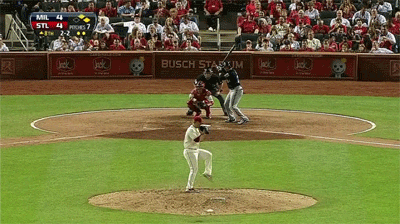
Time for a few more fouls. Gomez has the fourth-highest in-zone swing percentage of the 197 hitters who've seen at least 500 pitches this season (76.1 percent), so he's not going to take strike three. The only hitters who swing at a higher rate of in-zone pitches than Gomez are Pablo Sandoval and Josh Hamilton, who swing at everything, everywhere, and Matt Holliday. Holliday swings at 76.5 percent of pitches inside the zone, but only 29.3 percent of pitches outside of it. That difference of 47.2 percentage points between in- and out-of-zone swing percentages is the second largest in baseball. I was going to say that that explains why Holliday is such a good hitter—he swings at hittable pitches, and lets the rest go by—but the first- and third-largest percentage point differences between Z-Swing and O-Swing rates belong to Justin Ruggiano and Pete Kozma, respectively. Sooo.
9: 2-2: 99-mph four-seamer, foul
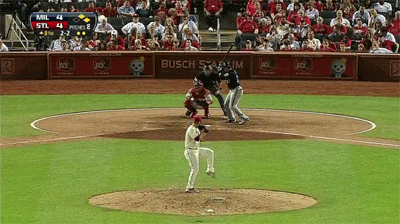
This is a mistake: Molina sets up outside, but Rosenthal misses his target and delivers a pitch almost perfectly centered in the strike zone. He gets away with it anyway, because he throws 99 mph.
After this pitch, Molina went to the mound for a chat with Rosenthal. Maybe they discussed whether to show Gomez something else or throw him a 10th consecutive fastball.
10: 2-2: 97-mph four-seamer, foul

Fastball won.
“About time to end this at-bat,” says Mike Shannon on the Cardinals broadcast. Gomez disagrees.
11: 2-2: 89-mph changeup, foul

On the 11th pitch of the plate appearance, Rosenthal throws a changeup, which Gameday classifies as a fastball because even Rosenthal's changeups average almost 90 miles per hour. Gomez still gets a piece of it, although this time he's early instead of late.
12: 3-2: 89-mph changeup, ball
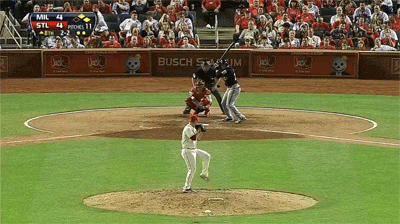
This is the sort of thing that happens when Rosenthal throws changeups. Maybe he should throw more fastballs! The runners advance. (Oh, have I mentioned that there are runners? There are runners.)
13: 3-2: 98-mph four-seamer, ball
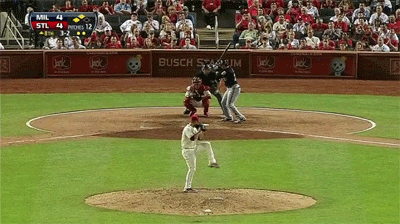
Rosenthal goes back to his heater and misses inside, and Gomez takes a rare walk. That's a pretty good long plate appearance. And this should make you appreciate Gomez more: the next batter, Yuniesky Betancourt, struck out swinging on an 0-2 changeup after fouling off, whiffing, and fouling off three four-seam fastballs.
Thank you for reading
This is a free article. If you enjoyed it, consider subscribing to Baseball Prospectus. Subscriptions support ongoing public baseball research and analysis in an increasingly proprietary environment.
Subscribe now
Also: "Goldschmidt had a .769 OPS vs. right-handed hitters and a .996 OPS vs. left-handed hitters."
Did you mean pitchers instead of "hitters."
Any clue what I might be referring to?